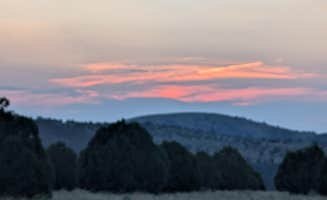Dispersed camping near Whiteriver, Arizona occurs primarily on Apache-Sitgreaves National Forest lands where elevations create distinct microclimates between sites. Free camping options range from sites near water features to forest clearings with varying levels of seclusion. Vehicle access varies seasonally, with many roads becoming impassable after precipitation without high-clearance 4WD vehicles.
What to do
Wildlife viewing opportunities: The dispersed sites around Carnero Spring Road attract numerous wildlife species, with one camper noting they "camped in the clearing by the lake. Some traffic came through but not bothersome." For families seeking animal encounters, this area delivers consistent sightings.
Hiking accessible trails: Campers staying at Timber Mesa Trailhead appreciate the well-marked paths and proximity to town. As Robert H. reports, "clearly marked trails and roadways. Hiking views were spectacular." The trail system offers routes suitable for various skill levels.
Fishing opportunities: Several forest access roads lead to quality fishing spots throughout the region. The trout waters attract anglers year-round, though catch rates diminish during mid-summer heat. Access points often become crowded on holiday weekends, requiring early arrival to secure premium spots.
What campers like
Solitude and remoteness: Many Forest Service roads provide secluded camping opportunities. A visitor to National Forest Road 117C shared their experience: "Only a couple logging trucks on a very nice maintained road. All alone on a mountain top!! Me and my dog are living the life!"
Lake access camping: Despite seasonal fluctuations in water levels, Concho Lake remains popular for its accessible waterfront sites. According to Michael R., there are "nice spread out campsites right on concho lake. Trash, port-a-potties on site." The proximity to water attracts campers seeking cooler temperatures.
Variety of terrain: The elevation changes create distinct camping environments within short driving distances. Sites like Beehive Spring Camp offer different forest compositions as noted by Gerald P.: "Nice couple of sites with a variety of trees not just Ponderosa Pine." This diversity allows campers to select microclimates based on seasonal preferences.
What you should know
Road conditions vary significantly: Many forest roads deteriorate quickly with weather events. Linda C. warns about National Forest Road 117C: "Don't try to make it to the shared coordinates soon after a snow melt. Grateful for our GoTreads." Always check recent conditions before committing to remote sites.
Temperature fluctuations: Higher elevation sites experience dramatic temperature drops after sunset, even during summer months. At Beehive Spring Camp, Gerald P. noted it "got cold at night in September" due to its 9,200-foot elevation. Pack appropriate layers regardless of season.
Sanitation management: Facilities range from portable toilets at more developed sites to completely primitive areas. At Concho Lake, Monte W. observed, "There were two port o potty's that were not too bad." During peak periods, maintenance can lag behind usage rates.
Tips for camping with families
Best sites for children: Locations with defined boundaries help contain young explorers. Concho Lake offers family-friendly options as Heather E. describes: "The lake was frozen over which made for tons of fun for us throwing rocks and listening to the ripple." Look for sites with natural play features.
Wildlife viewing with kids: Several locations offer reliable wildlife encounters appropriate for children. Abby M. noted at Concho Lake, "There's prairie dogs and bunnies galore, which was a nice bonus." Morning and evening hours yield the most active wildlife periods.
Safety considerations: Prepare children for wildlife encounters and weather changes. Teach proper food storage protocols, especially in areas with reported predator activity. One camper at Timber Mesa Trailhead discovered they were "only a few steps away from a mountain lion kill site!"
Tips from RVers
Pad availability: Some dispersed sites offer concrete pads suitable for smaller rigs. At Concho Lake, Twan M. found "most official sites have concrete pads & trashcans but a few more primitive spots just have driveways & rock campfire rings." These pads provide stability during wet conditions.
Cell service reliability: Remote workers can find usable connectivity at select locations. Andy observed at Concho Lake: "Good Verizon!" while other campers report usable AT&T coverage. Signal strength diminishes quickly when moving away from main roads and elevations.
Resource management: Pack in all water needs as reliable sources are scarce. Firewood gathering becomes increasingly difficult at heavily-used sites. Monte W. advised: "I was able to find fire wood around for a fire but it was a little challenging finding larger pieces of wood, I would probably bring some wood of my own if I ever returned."





